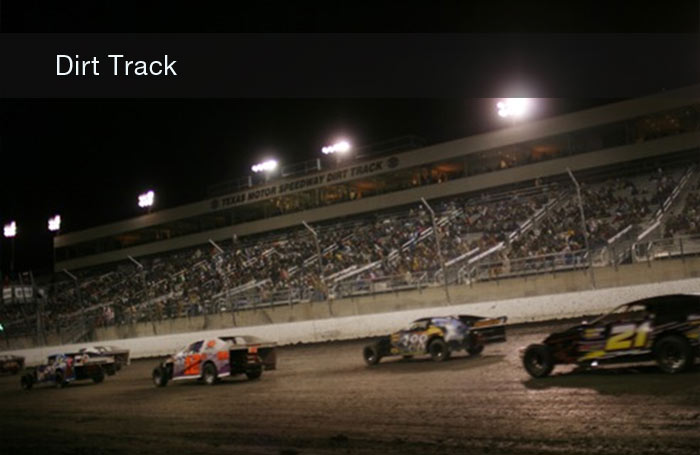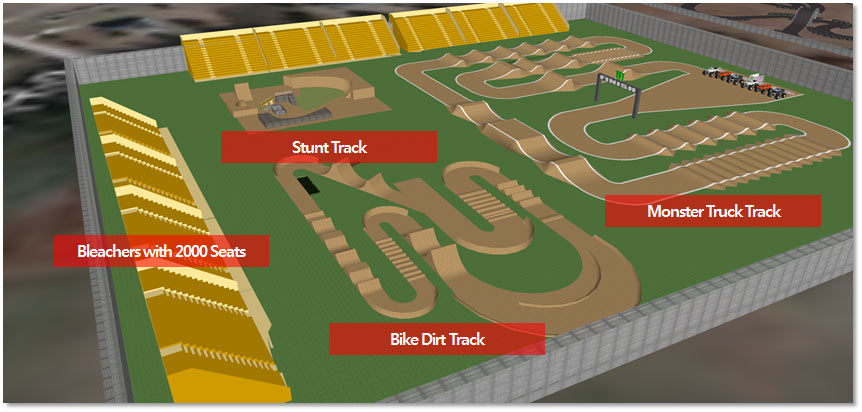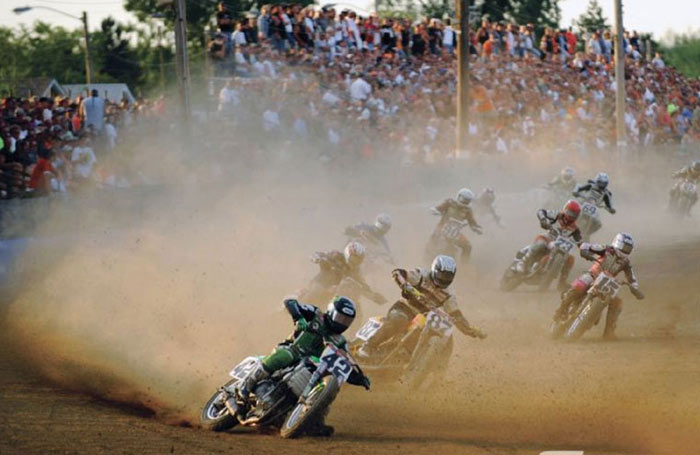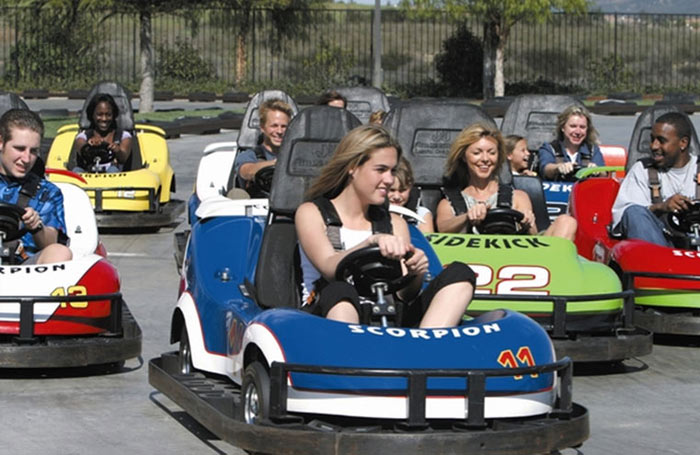
Monster Truck Track History

In the late 1970s, modified pickup trucks were becoming popular and the sports of mud bogging and truck pulling were gaining in popularity. Several truck owners had created lifted trucks to compete in such events, and soon competition to hold the title of "biggest truck" developed. The trucks which garnered the most national attention were Bob Chandler's Bigfoot, Everett Jasmer's USA-1, Fred Shafer and Jack Willman Sr.'s Bear Foot, and Jeff Dane's King Kong. At the time, the largest tires the trucks were running were 48 inches in diameter.
In April 1981, Bob Chandler drove over cars in Bigfoot in what is often believed to be the first monster truck to crush cars. Chandler drove Bigfoot over a pair of cars in a field as a test of the truck's ability, and filmed it to use as a promotional tool in his four wheel drive performance shop. An event promoter saw the video of the car crush and asked Chandler to do it in front of a crowd. Initially hesitant because of the "destructive" image that could be associated with Bigfoot, Chandler eventually caved in. After some smaller shows, Chandler performed the feat in the Pontiac Silverdome in 1982. At this show, Chandler also debuted a new version of Bigfoot with 66 inch (1.7 m) diameter tires. At a prior event in the early 80's when BIGFOOT was still running 48″ terra tires, Bob George, one of the owners of a motorsport promotion company named Truck-a-rama (now the USHRA), is said to have coined the phrase "monster truck" when referring to BIGFOOT. The term "monster truck" became the generic name for all trucks with oversized terra tires.
Debate over who did the first car crush is often discussed. There are claims that in the late 1970s, Jeff Dane's King Kong (who referred to his truck as the "Bigger Foot") had crushed cars at Great Lakes Dragway in Union Grove, Wisconsin. Another truck, known as High Roller, also claimed to have documented car crushes in Washington State before Bigfoot, though said documentation has never surfaced. Cyclops, then owned by the Dykman Brothers, also claims to have crushed burning cars before Bigfoot. However, the earliest, widely-available and verified video footage showing a monster truck crushing cars that exists shows Bob Chandler driving Bigfoot while crushing two mid-seventies automobiles in April 1981. This video was what the promoter viewed that motivated him to ask Chandler to perform the car crush in front of a crowd.
King Kong and Bear Foot each followed Bigfoot to 66-inch-diameter (1,700 mm) tires, and soon other monster trucks, such as King Krunch, Maddog, and Virginia Giant were being constructed. These early trucks were built off of stock chassis which were heavily reinforced, used leaf spring suspension, a stock body, and heavy military axles to support the tires. As a result, the trucks were incredibly heavy (usually 13,000 to 20,000 lb.) and most times had to crawl up onto the cars.
For most of the early 1980s, monster trucks performed primarily exhibitions as a side show to truck pulling or mud bogging events. In 1985, major promoters, such as the USHRA and TNT Motorsports, began racing monster trucks on a regular basis. The races, as they are today, were in the form of single elimination drag races, held over a course littered with obstacles. The change to racing eventually led truck owners to begin building lighter trucks, with more power. The establishment of TNT's first-ever monster truck points championship in 1988 expedited the process and found teams beginning to use straight-rail frames, fiberglass bodies, and lighter axle components to shave weight and gain speed.
In 1988, to standardize rules for truck construction and safety, Bob Chandler, Braden, and George Carpenter formed the Monster Truck Racing Association (MTRA). The MTRA created standard safety rules to govern monster trucks. The organization still plays a major role in the sport's development in the USA and EU.
With racing taking precedence, several teams began to think in new ways as to how the trucks could be built. Towards the end of 1988, Gary Cook and David Morris debuted Equalizer, a truck with a combination of coil springs and shock absorbers as the main source of suspension rather than the standard of leaf springs and shock absorbers. In 1989, Jack Willman Sr., now with his own truck, Taurus, debuted a new truck which used a four-link suspension system and large coilover shock absorbers, and that weighed in at close to 9,000 lb. However, the ultimate coup de grâce came from Chandler, also in 1989, whose Bigfoot VIII featured a full tubular chassis and a long-travel suspension using cantilevers and nitrogen shock absorbers to control the suspension. The truck revolutionized how monster trucks were built, and within a few years most top level teams built similar vehicles.
In 1991, TNT was purchased by USHRA and their points series were merged. The Special Events championship began to grow in popularity with teams as it had open qualifying spots which the invite-only USHRA championship did not have. The Special Events series lost its Pendaliner sponsorship in 1996, but the series is still running. The short-lived ProMT series started in 2000.
Even though racing was dominant as a competition, USHRA events began having freestyle exhibitions as early as 1993. These exhibitions were developed as drivers, notably Dennis Anderson of the extremely popular Grave Digger, began asking for time to come out and perform if they lost in early rounds of racing. Promoters began to notice the popularity of freestyle among fans, and in 2000 USHRA began holding freestyle as a judged competition at events, and now even awards a freestyle championship Monster Jam is currently the largest and premier monster truck event promoter, touring not only through the United States, but Canada and select regions of Europe. Other promoters of monster truck events include Checkered Flag Productions, AMP Tour, Special Events 4 Wheel & Off Road Jamboree, Major League of Monster Trucks, Extreme Monster Truck Nationals, MTRSS, Monster Truck Challenge and Monster Nationals draw huge crowds.
|

Dirt Track Route : Monster Truck Track, Bike Tracks Stunt Track, Bleachers (2000 Seats)
Bike Dirt Track

Dirt Track bikes have capacities of 250, 350, 500 and in the solo classes and can reach speeds of up to 80 mph (130 km/h) on the straights and with no brakes fitted to the machine. The American Grand National dirt track championship uses motorcycles of up to 750 cc capacities and can reach speeds of up to 130 mph (210 km/h).
There are three sidecar classes. The continental class has a 500 cc single-cylinder engine, also in Great Britain there are left- and right-handed sidecar machines with the engines up to 1000 cc. Sidecar races are some of the most exciting in Grass Track sport, with the driver and passenger working together to obtain the best grip and speed around the corners. Dirt Track Racing draws a lot of spectators to the sport.
|
|
Go-Kart Track

A go-kart is a small four-wheeled vehicle. Go-karts come in all shapes and forms, from motorless models to high-powered racing machines, some, like Superkarts, being able to beat racing cars on long circuits.
Gravity racers, usually referred to as soap-box carts, are the simplest type of go-karts. They are propelled by gravity, with some races taking place down a single hill.
Amusement park go-karts can be powered by 4-stroke engines or electric motors, while racing karts use small 2-stroke or 4-stroke engines. Most of them are single seater but recreational models can sometimes accommodate a passenger. This is a safe family fun event and very profitable for the operator of the park.
|
|

|
|
|
















